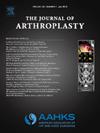Predictive Modeling of Medical and Orthopaedic-Related 90-Day-Readmissions Following Primary Total Knee Arthroplasty
IF 3.4
2区 医学
Q1 ORTHOPEDICS
引用次数: 0
Abstract
Background
As the demand for total knee arthroplasty (TKA) escalates, 90-day readmissions have emerged as a pressing clinical and economic concern for the current value-based health care system. Consequently, health care providers have focused on estimating the risk levels of readmitted patients; however, it is unknown if specific factors are associated with different types of complications (ie, medical or orthopaedic-related) that lead to readmissions. Therefore, this study aimed to (1) determine the overall, medical-related, and orthopaedic-related 90-day readmission rate and (2) develop a predictive model for risk factors affecting overall, medical-related, and orthopaedic-related 90-day readmissions following TKA.
Methods
A prospective cohort of primary unilateral TKAs performed at a large tertiary academic center in the United States from 2016 to 2020 was included (n = 10,521 patients). Unplanned readmissions were reviewed individually to determine their primary cause, either medical or orthopaedic-related. Orthopaedic-related readmissions were specific complications affecting the joint, prosthesis, or surgical wound. Medical readmissions were due to any other cause requiring medical management. Multivariable logistic regression models were used to investigate associations between prespecified risk factors and 90-day readmissions, as well as medical and orthopaedic-related readmissions independently.
Results
Overall, the rate of 90-day readmissions was 6.7% (n = 704). Over 82% of these readmissions were due to medical-related causes (n = 580), with the remaining 18% being orthopaedic-related (n = 124) readmissions. The area under the curve for the 90-day readmission model was 0.68 (95% confidence interval: 0.67 to 0.70). Sex, smoking, length of stay, and discharge disposition were associated with orthopaedic readmission, while age, sex, race, the Charlson Comorbidity Index, insurance, surgery day, opioid overdose risk score, length of stay, and discharge disposition were associated with medical-related 90-day readmissions.
Conclusions
Medical-related readmissions after TKA are more prevalent than orthopaedic-related readmissions. Through successfully constructing and validating multiple 90-day readmission predictive models, we highlight the distinct risk profiles for medical and orthopaedic-related readmissions. This emphasizes the necessity for nuanced, patient-specific risk stratification and preventive measures.
初级全膝关节置换术后医疗和矫形相关 90 天再住院预测模型。
背景:随着人们对全膝关节置换术(TKA)需求的增加,90 天再入院已成为当前以价值为基础的医疗保健系统亟待解决的临床和经济问题。因此,医疗服务提供者将重点放在了估计再入院患者的风险水平上;然而,导致再入院的不同类型并发症(即内科或骨科相关并发症)是否与特定因素相关,目前还不得而知。因此,本研究旨在(1) 确定总体、医疗相关和矫形相关的 90 天再入院率;(2) 针对影响 TKA 术后总体、医疗相关和矫形相关 90 天再入院率的风险因素建立预测模型:方法:纳入2016年至2020年在美国一家大型三级学术中心进行的初级单侧TKA前瞻性队列(n = 10,521名患者)。对非计划再入院患者进行了逐一审查,以确定其主要病因(医疗或矫形相关)。骨科相关再入院指的是影响关节、假体或手术伤口的特定并发症。医疗相关再入院指的是由于任何其他需要医疗管理的原因造成的再入院。多变量逻辑回归模型用于研究预先指定的风险因素与90天再入院率之间的关系,以及医疗/矫形相关再入院率之间的关系:总体而言,90 天再入院率为 6.7%(n = 704)。超过82%的再入院病例是由于医疗相关原因造成的(n = 580),其余18%为骨科相关再入院病例(n = 124)。90天再入院模型的AUC为0.68(95% CI[置信区间]:0.67至0.70)。性别、吸烟、住院时间(LOS)和出院处置(DD)与骨科再入院相关,而年龄、性别、种族、查尔森综合指数(CCI)、保险、手术日、阿片类药物过量风险(NARX)评分、住院时间和出院处置与医疗相关的90天再入院相关:结论:TKA术后医疗相关再入院率高于骨科相关再入院率。通过成功构建和验证多个 90 天再入院预测模型,我们强调了医疗和矫形相关再入院的不同风险特征。这强调了对患者进行细致入微的风险分层和采取预防措施的必要性。
本文章由计算机程序翻译,如有差异,请以英文原文为准。
求助全文
约1分钟内获得全文
求助全文
来源期刊

Journal of Arthroplasty
医学-整形外科
CiteScore
7.00
自引率
20.00%
发文量
734
审稿时长
48 days
期刊介绍:
The Journal of Arthroplasty brings together the clinical and scientific foundations for joint replacement. This peer-reviewed journal publishes original research and manuscripts of the highest quality from all areas relating to joint replacement or the treatment of its complications, including those dealing with clinical series and experience, prosthetic design, biomechanics, biomaterials, metallurgy, biologic response to arthroplasty materials in vivo and in vitro.
 求助内容:
求助内容: 应助结果提醒方式:
应助结果提醒方式:


